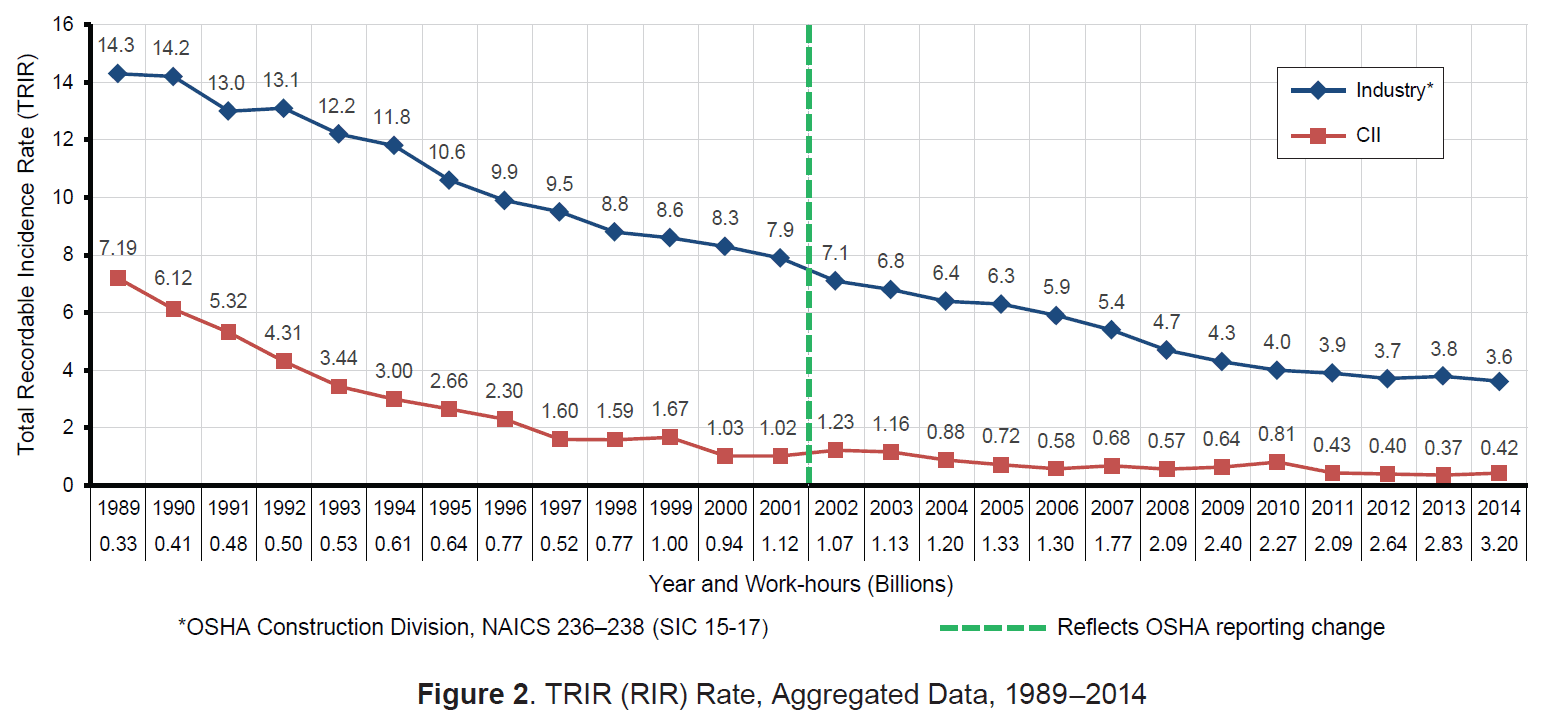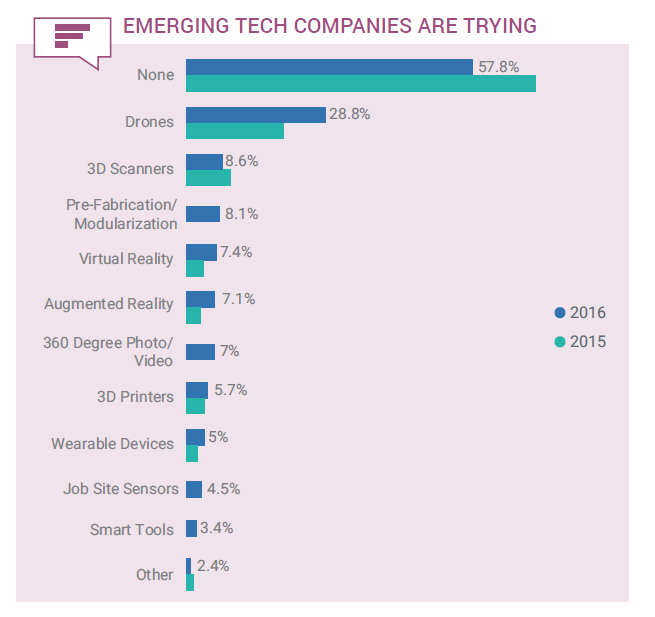The construction industry’s track record to adopt new technologies in the field has been well behind adoption seen in other sectors. One of the primary barriers when adopting new technologies are the uncertain aspects when it comes to worker safety on the jobsite.
As a workplace, the construction jobsite is a fast-paced, high pressure, and constantly evolving environment from project start to completion. Over the past couple of decades, project stakeholders and industry consortiums such as the Construction Owners of Alberta Association, the Construction Industry Institute (CII) and Fiatech have invested heavily in improving safety performance on jobsites. The results are impressive:

Source: CII 2015 Safety Report (PAC 2015-2)
A sustained effort to create a Culture of Safety on jobsites and encourage worker ownership over safety has driven down the Total Recordable Incident Rate (TRIR) over the past few decades. A big part of these efforts introduced workplace processes such as Job Hazard Assessments, Site-wide Safety Plans and Safety Assessments as part of overall workface planning efforts.
Along with metrics and reporting on incidence, a lot of work has been done and continues to be done with respect to reducing incidents and adding more predictability to safe work procedures.
New technologies have helped the cause by offering new tools to make field data capture easier, improve storage and analysis of data, automate data collection and improve work instructions. The most prevalent technology are mobile devices used for field data collection, according to the 2016 5th Annual Construction Technology Report compiled by JBKnowledge:

Source: JBKnowledge 2016 Construction Technology Report
In addition, some companies are trying new technologies that may increase productivity further according to the same survey:

Source: JBKnowledge 2016 Construction Technology Report
Diving deeper into some of these technologies below, we have gauged their impact on safety and provided practical guidelines based on Intelliwave’s experience deploying new technologies into the field.
New Technology Trends and Implications
Mobile Technologies
The use of field mobile apps has increased steadily over the past several years. Mobile apps can add a lot of value to construction, but also pose certain risks from a safety perspective. In order to mitigate any risks we recommend the following:
- When a user looks at a mobile device in the field he is distracted from everything around him. In our training, we teach people to always move to out of high traffic areas and never look at the device while walking at the same time.
- Mobile devices can be cumbersome to handle and carry if they aren’t equipped with the right accessories; make sure users are equipped and trained to use the devices properly
- On certain jobsites with intrinsically safe requirements, devices should be certified for use and training provided with respect to the exact classification of each device.
In addition, mobile software vendors need to ensure that they are contributing to the culture of safety in construction by developing features that empower safety:
- High contrast display to maximize outdoor visibility
- Offline access for seamless operation
- Quick access to information
- Augmented reality features can be used to improve user visibility of surroundings while looking at screen, care needs to be taken to make sure this isn’t too much of a distraction
Sensor Technologies
Sensor technologies include barcodes, passive and active RFID tags, GPS trackers and even mobile devices themselves. The use of these provide a way to accurately identify or provide an automated feed of information regarding construction resources such as materials, equipment and workforce.
Sensor technologies can lead to the benefits for jobsite safety:
- Better information leads to less overall time in the field for workers
- Automated data provides improved analysis and can be used for incident prediction
However, the following items should be considered when using sensors or tracking devices:
- Use only devices that are rugged enough for a construction jobsite
- Make sure the devices are attached using an appropriate method for the environment. For example, in order for barcode labels to survive in outdoor environments, a permanent acrylic adhesive should be used when applying the barcode to the item
- Train workers about proper methods for removing and recycling tracking devices, as well as their proper operation.
Wearables
Experiments in the use of wearables for tracking workforce health and fatigue has occurred recently on jobsites. Wearables are seeing a rise on the consumer side, which will normally lead to adoption in enterprises. These devices present similar challenge with distraction, but can provide valuable data similar to sensors regarding workforce heath and even tool and construction equipment health.
Drones
Drone technology interest has seen a big uptick lately and we should continue to see an increased use of drones as well as autonomous vehicles and construction equipment in the future. It is however extremely important to consider their safety implications:
- Pre-determined flight paths on evolving sites present dangers in addition to regulations in some countries which disallow this altogether — probably best to avoid these
- These devices present distractions to workers especially on Aerial Work Platforms where the highest precautions need to be taken to avoid falls. It is important to provide training and education to crew and also consider areas where and when they operate
- Wind gusts and bad weather can make it difficult to control flying drones which increases the risk of a crash and ultimately worker injury or death in the worst case outcomes
Conclusion
While it is important to analyze and mitigate safety impacts when introducing new technologies on construction sites, we have seen and should continue to see a trend of reduced incidents on large construction projects with the aid of new technologies.
It is important that new construction technology contributes to the culture of safety and not disrupt or distract from it.